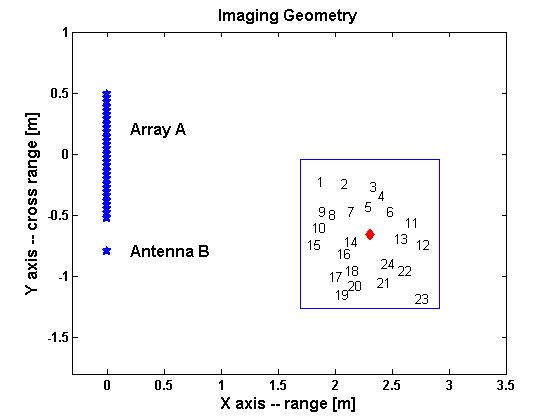Project – Time Reversal Synthetic Aperture Radar
- Project Description: this project aims to study time reversal for synthetic aperture radar imaging. About Time Reversal Synthetic Aperture RadarWhen imaging a target, the conventional SAR theory does not include the effects of multiple scattering from the surrounding objects in a high clutter area. In addition to the true target image, multiple-bounce echoes caused by surrounding scatterers produce spurious and random patterns in the formed SAR image. We refer to these as ghost images. In this paper, we combine time reversal with synthetic aperture radar (TR-SAR) to reduce or remove ghost patterns and form a clean target map in a high clutter scene. Furthermore, once we identify a target spot, we can examine the shape or the size of the target with improved resolution. The following example shows how, from a rough estimate of the target location obtained from a conventional SAR image and using time reversal, TR-SAR focuses on the target with improved resolution, and reduces or removes ghost images. Verification with experimentally measured electromagnetic data demonstrates the success of TR-SAR.


- Fig.-1: The left figure shows the bi-static squint mode SAR imaging geometry. A horn antenna moves along the rail A and transmits signals, and a fixed antenna B receives signals. There are a total of 24 scatterers and one single target. The right figure shows the conventional SAR image. The thicker and shorter cross indicates the exact target location, while the larger corss indicates the peak of the image. The numbers indicate the locations of the scatterers. We observe that there are a large amount of ghost patterns in the SAR image. These ghost patterns are caused by multipaths.

- Fig.-2: Left figure shows the TR-SAR image. The image is cleaner with an improved resolution. The ghost patterns are removed. The right figure shows the range and the cross range projection of the SAR image in Fig.-4 and of the TR-SAR image. The TR-SAR image shows a much better resolution, the sidelobe is much lower than that of the conventional SAR image.
Selected Publications:
- Y. Jin, J. M. F. Moura, N. O’Donoughue, “Experimental study of extended target imaging by time reversal SAR”, International Conference on Acoustics, Speech, and Signal Processing, ICASSP’09, Taiwan, April 19-26, 2009, IEEE.
- Y. Jin, J.M.F. Moura, M. Mulford, N. O’Donoughue, A. Samuel, “Time reversal spotlight SAR in Multipath”, 41th Asilomar Conference on Signals, Systems and Computers 2007 [Full-Text]


